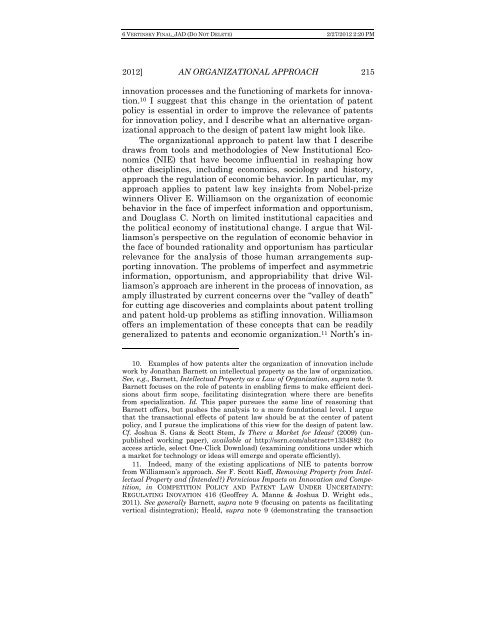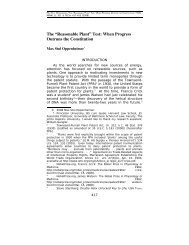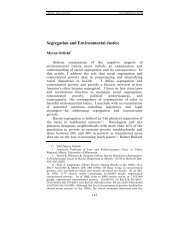An Organizational Approach to the Design of Patent Law
An Organizational Approach to the Design of Patent Law
An Organizational Approach to the Design of Patent Law
You also want an ePaper? Increase the reach of your titles
YUMPU automatically turns print PDFs into web optimized ePapers that Google loves.
6 VERTINSKY FINAL_JAD (DO NOT DELETE) 2/27/2012 2:20 PM<br />
2012] AN ORGANIZATIONAL APPROACH 215<br />
innovation processes and <strong>the</strong> functioning <strong>of</strong> markets for innovation.<br />
10 I suggest that this change in <strong>the</strong> orientation <strong>of</strong> patent<br />
policy is essential in order <strong>to</strong> improve <strong>the</strong> relevance <strong>of</strong> patents<br />
for innovation policy, and I describe what an alternative organizational<br />
approach <strong>to</strong> <strong>the</strong> design <strong>of</strong> patent law might look like.<br />
The organizational approach <strong>to</strong> patent law that I describe<br />
draws from <strong>to</strong>ols and methodologies <strong>of</strong> New Institutional Economics<br />
(NIE) that have become influential in reshaping how<br />
o<strong>the</strong>r disciplines, including economics, sociology and his<strong>to</strong>ry,<br />
approach <strong>the</strong> regulation <strong>of</strong> economic behavior. In particular, my<br />
approach applies <strong>to</strong> patent law key insights from Nobel-prize<br />
winners Oliver E. Williamson on <strong>the</strong> organization <strong>of</strong> economic<br />
behavior in <strong>the</strong> face <strong>of</strong> imperfect information and opportunism,<br />
and Douglass C. North on limited institutional capacities and<br />
<strong>the</strong> political economy <strong>of</strong> institutional change. I argue that Williamson’s<br />
perspective on <strong>the</strong> regulation <strong>of</strong> economic behavior in<br />
<strong>the</strong> face <strong>of</strong> bounded rationality and opportunism has particular<br />
relevance for <strong>the</strong> analysis <strong>of</strong> those human arrangements supporting<br />
innovation. The problems <strong>of</strong> imperfect and asymmetric<br />
information, opportunism, and appropriability that drive Williamson’s<br />
approach are inherent in <strong>the</strong> process <strong>of</strong> innovation, as<br />
amply illustrated by current concerns over <strong>the</strong> “valley <strong>of</strong> death”<br />
for cutting age discoveries and complaints about patent trolling<br />
and patent hold-up problems as stifling innovation. Williamson<br />
<strong>of</strong>fers an implementation <strong>of</strong> <strong>the</strong>se concepts that can be readily<br />
generalized <strong>to</strong> patents and economic organization. 11 North’s in-<br />
10. Examples <strong>of</strong> how patents alter <strong>the</strong> organization <strong>of</strong> innovation include<br />
work by Jonathan Barnett on intellectual property as <strong>the</strong> law <strong>of</strong> organization.<br />
See, e.g., Barnett, Intellectual Property as a <strong>Law</strong> <strong>of</strong> Organization, supra note 9.<br />
Barnett focuses on <strong>the</strong> role <strong>of</strong> patents in enabling firms <strong>to</strong> make efficient decisions<br />
about firm scope, facilitating disintegration where <strong>the</strong>re are benefits<br />
from specialization. Id. This paper pursues <strong>the</strong> same line <strong>of</strong> reasoning that<br />
Barnett <strong>of</strong>fers, but pushes <strong>the</strong> analysis <strong>to</strong> a more foundational level. I argue<br />
that <strong>the</strong> transactional effects <strong>of</strong> patent law should be at <strong>the</strong> center <strong>of</strong> patent<br />
policy, and I pursue <strong>the</strong> implications <strong>of</strong> this view for <strong>the</strong> design <strong>of</strong> patent law.<br />
Cf. Joshua S. Gans & Scott Stem, Is There a Market for Ideas? (2009) (unpublished<br />
working paper), available at http://ssrn.com/abstract=1334882 (<strong>to</strong><br />
access article, select One-Click Download) (examining conditions under which<br />
a market for technology or ideas will emerge and operate efficiently).<br />
11. Indeed, many <strong>of</strong> <strong>the</strong> existing applications <strong>of</strong> NIE <strong>to</strong> patents borrow<br />
from Williamson’s approach. See F. Scott Kieff, Removing Property from Intellectual<br />
Property and (Intended?) Pernicious Impacts on Innovation and Competition,<br />
in COMPETITION POLICY AND PATENT LAW UNDER UNCERTAINTY:<br />
REGULATING INOVATION 416 (Ge<strong>of</strong>frey A. Manne & Joshua D. Wright eds.,<br />
2011). See generally Barnett, supra note 9 (focusing on patents as facilitating<br />
vertical disintegration); Heald, supra note 9 (demonstrating <strong>the</strong> transaction






